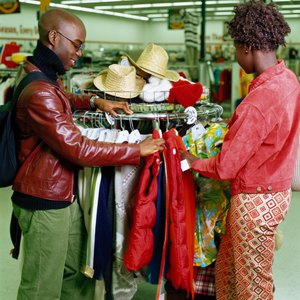
Consignment shops and thrift stores both sell used items at discounted prices. You may choose to work with a consignment shop if you want to make money by selling a used item. If you just want someone to take the item off your hands, visit a thrift shop. In terms of buying options, expect to find different types and qualities of items in consignment vs. thrift stores.
Sometimes a store's consignment policy isn't clear. If you have items you want to sell, don't hesitate to call and ask whether they purchase or consign items. It will save you a trip if the store turns out to be a donation-only thrift store.
Inventory Comes From Different Sources
The main difference between a consignment vs. thrift shop boils down to where the inventory comes from. A thrift store usually receives donated items. If the thrift store operates as a 501(c)3 non-profit, it can distribute tax-deductible receipts for the donations. Otherwise, it merely accepts people's unwanted items, and the donor receives no compensation whatsoever. These stores usually accept everything as-is and later decide whether it's worth selling.
A consignment shop is designed to provide a financial benefit to both the shop owner and the item owner. If the shop owner agrees to consign the item, they'll place it in their shop at the item owner's desired sale price. The item owner retains full rights over the item and can retrieve it at any time. When the item sells, the shop owner takes a percentage of the sale and then writes the item owner a check for the remainder.
Consignment shops may also place a time limit on how long an item can remain in the store before the owner must retrieve it.
Read more: Donation vs. Consignment
This is different from a pawn shop, which promises quick cash because the shop owner purchases the item directly from the seller. Other types of stores you may encounter include flea markets, antique malls and resale stores. These aren't necessarily set up to be consignment or thrift stores. The store or booth owners typically go to estate sales or yard sales – or even pawn shops, consignment shops and thrift stores – to purchase items that they believe they can sell for a higher price.
Perceived Quality of Consignment vs. Thrift
Consignment stores tend to be considered more "upscale" than thrift stores because the original owner believes the item to be valuable enough to sell. Crucially, the consignment owner agrees that the item is valuable and is willing to display it in their store. In contrast, thrift stores receive items that people ultimately want to get rid of rather than take the time to sell. Thrift stores do perform a quality check to make sure items are still in good condition or, in the case of electronics, still work.
Read more: How to Donate to a Thrift Store
Price of Items at Thrift vs. Consignment Shops
What you find in a consignment store will probably be more expensive than what you find in a thrift store. The item owner intends to make a certain amount of money and must also factor in the shop owner's cut when determining the final price. Thrift stores can afford to sell items cheaply because they received them for free. They'll make a profit no matter what, and moving inventory quickly helps make room for more items.
You can typically haggle about prices in both stores. It's easier to negotiate a lower price at a thrift store if you're making a bulk purchase or if the item has an obvious defect. At a consignment shop, the shop owner has to call the item owner to relay your offer. You might not get an answer right away.
References
Tips
- Ask around for a referral on a great shop near you!
- GO GREEN, SHOP GREEN!
- SAVE, SAVE, SAVE and EARN, EARN, EARN!
Writer Bio
Cathy has been writing about finance since 2014 and has been published on sites like The Nest, Bizfluent, Financial Independence Hub, and Credibly. She takes a particular interest in demystifying personal finance questions, like budgeting, tackling debt, and investing for the future.

